Canine Coat Color Basics
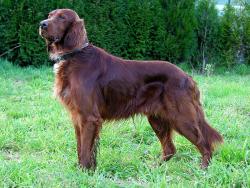
This Irish Setter is an example of a dark red coat without dilutions or white patterns. It could carry dominant black KB. Open Source Photo
A dog displaying Kbr. He is KbrKy because his dam was not dominant black or brindle. Although the mask is difficult to see, he is EM and ay at agouti
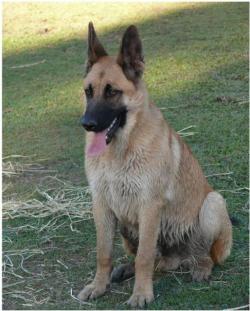
An example of EM. You can clearly see this dog's dark face mask. This dog will also be ay, due to its fawn coloring. Photo Courtesy of S. McArdle

A wolf displaying the aw agouti allele. You can clearly see the bands of color in the coat. Open Source Photo
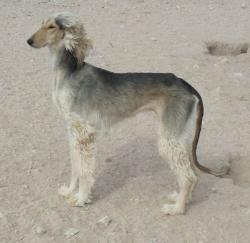
Domina, a 75% Afghan, and 25% Saluki dog, displaying the grizzle/domino pheonotype. Photo courtesy of DesertWindHounds.
Colors: Black, Yellow, and Red
Canines produce two types of pigment: eumelanin, which is black pigment; and phaeomelanin which is red/yellow pigment. It is the combination of these pigments, along with dilutions, modifiers, and white patterns, that make up the entire spectrum of dog coat colors.
In dogs and wolves there are four known alleles of the extension locus: EM, EG, E, and e. In the absence of dilutions or white patterns, a dog that is ee will be red or yellow. Its skin and eyes will still be dark, but the coat will only contain red or yellow pigment; thereby producing a red or yellow dog. In an ee dog, many other genes are masked. They are there, and will still be passed on to offspring, but they will not express. Dilutions and white patterns will still affect an ee dog.
If a dog is EM, EG, or E, then it will produce black pigment in its coat. The extent of this black pigment will be determined by other genes.
These occur at the K locus and the A locus.Dominant Black and Brindle
The K locus determines whether a dog is solid black (KB) or brindle (Kbr). As long as the dog is not ee, if it carries KB, the dog will be black. This includes KBKB, KBkbr, and KBky (ky being not black or brindle). This black is often referred to as "dominant black," because it dominates all other colors, with the exception of ee.
If a dog is not ee, and does not carry KB, then many other genes are allowed to express.
The EM and EG alleles will be allowed to do something besides turn on black pigment. The EM allele will enable a mask. If the right conditions are met, the EG allele will express the grizzle, or domino, pheonotype. The alleles of the A locus will also be allowed to express, as well as the Kbr (brindle) allele, which organizes black pigment into stripes in the coat.In the E locus, the order of dominance is: EM, EG,E, and e. It may seem a bit strange that the recessive allele, e, masks the expression of so many other genes; but that is indeed the way it works. For more information about dominant black and brindle see Brindle in Dogs: New Information about Stripes.
Agouti: Fawn, Sable, Wolf, Black and Tan, and Saddle
Dogs have at least four (4) agouti alleles, and more may yet be discovered. These are, in order of dominance: ay, aw, at, and a. There has also been an as allele theorized. But recent evidence presented at the conference on Advances in Canine and Feline Genomics and Inherited Disease in Baltimore, MD (from Sept. 23-25, 2010), seems to indicate it is not a separate allele.
The ay allele will result in a fawn or sable appearance. Clear fawns that do not carry EM can be difficult to distinguish from an ee dog. But they will usually have some black hair, if searched thoroughly. The ay dogs can be found with and without a mask.
Sable ay dogs will be darker than their fawn counterparts, and the hair is banded with black tips. They can sometimes be difficult to distinguish from the wolf (aw) dog. The Wolf allele (aw) is thought to be the original agouti, and is known as wild type. It is commonly seen in wolves, and is the result of banded hair. Sables can also show banded hair. But unlike a sable, which will show black at the tips, and fawn or red over the rest of the hair, dogs with the wolf allele at agouti will show alternating bands of color along the length of the hair. It is one of the more rare agouti alleles, and can be found with, and without, a face mask.
The at allele is the third agouti allele. Dogs that are atat or ata display the classic "black and tan" or saddle (also known as high tan) phenotype. Dogs that are atat or ata can carry either EM, or be EE or Ee. Black and tan dogs will display a face mask if they carry EM. Black and tan dogs will only display grizzle/domino (EG) if they carry EG and do not carry EM. In fact, a dog must be atat for the grizzle allele (EG) to express. Grizzle (EG) is only present in Saluki and Afghans Hounds. These hounds do not carry the recessive a allele; therefore, they need to be atat to express grizzle/domino. Some black and tan dogs display the phenotype that is referred to as "saddle." In the past, this has been thought of as a separate agouti allele. But as stated above, recent studies have cast doubt on this theory.
The final agouti allele is a. The a allele is only found in a few breeds. It results in what is known as recessive black. Visually, it is indistinguishable from dominant black, but is recessive to all the other agouti alleles. It will only display if homozygous.
Dog Colors Flow Chart: Lets put it all together...
Comments Page
Yes, red is recessive but age
There are a couple of scenarios that could produce red pups out of black dogs: 1) One of the parents is solid black with no tan makings (not counting ticking). In Bluetick Coonhounds this is called "all blue" but I'm not sure if it is present in heelers. Then the parent would have to be heterozygous for dominant black (K) and also be ay at agouti. This would allow them to produce a red pup that is E_ ay_ In some breeds this combination is red. 2) They are black and tan based dogs that carry a recessive red.
Yes, red is recessive but age doesn't have anything to do with it. It sounds like since both the dog and the bitch are blue then they must both carry a recessive red to produce a red pup. When the genes combine you have a 25% chance of getting red (ee). It's just been luck that you haven't gotten any until now. There is a test for red that is offered at various labs. If you plan on replacing your breeding stock, after you have retired your current pair, and don't want red pups you can have prospective animals tested.
I wonder if you have seen
I wonder if you have seen this, they recently updated it January 2012: http://homepage.usask.ca/~schmutz/dogNo…
Skin color and hair color are
Skin color and hair color are closely related. For example you most often have areas of pink skin where there is a white pattern. Gray skin may be related to Dilution and brownish skin related to Brown (Liver). I'm sorry I can't be more specific without more information but I hope that helps a bit.
Black and Tan
Hi,
I raise Cane Corso. The color standard for our breed is: Acceptable colors are black, lighter and darker shades of gray, lighter and darker shades of fawn, and red. Brindling is allowed on all of these colors. Solid fawn and red, including lighter and darker shades, have a black or gray mask. The mask does not go beyond the eyes. There may be a white patch on the chest, throat, chin, backs of the pasterns, and on the toes.Disqualification: Any color with tan pattern markings as seen in black-and-tan breeds.
We are seeing a recent increase in puppies being born that are Black w/Tan points. Tan meaning light fawn to darker red. Is this possible without having black and tan colored dogs in the pedigree of the puppies born with these markings? Thank you for your time.
Yes it is very possible.
Yes it is very possible. Because dominant black does not allow expression of agouti a dominant black (or blue) dog can carry the black and tan at agouti and not express it. For example of two dogs who are black but are both heterozygous for dominant black and both heterozygous for black and tan at agouti EE Kky ayat are bred together the resultant pups will be
| E | A | K | % | Color |
|---|---|---|---|---|
| EE | ayay | KBKB | 6.25 | black |
| EE | ayay | KBky | 12.5 | Black |
| EE | ayay | kyky | 6.25 | Fawn |
| EE | ayat | KBKB | 12.5 | Black |
| EE | ayat | KBky | 25 | Black |
| EE | ayat | kyky | 12.5 | Fawn |
| EE | atat | KBKB | 6.25 | Black |
| EE | atat | KBky | 12.5 | Black |
| EE | atat | kyky | 6.25 | Black and Tan |
So 6.25% of pups from this genetic combination will be black and tan. Hope this helps feel free to contact me or use the forum if you have more questions.
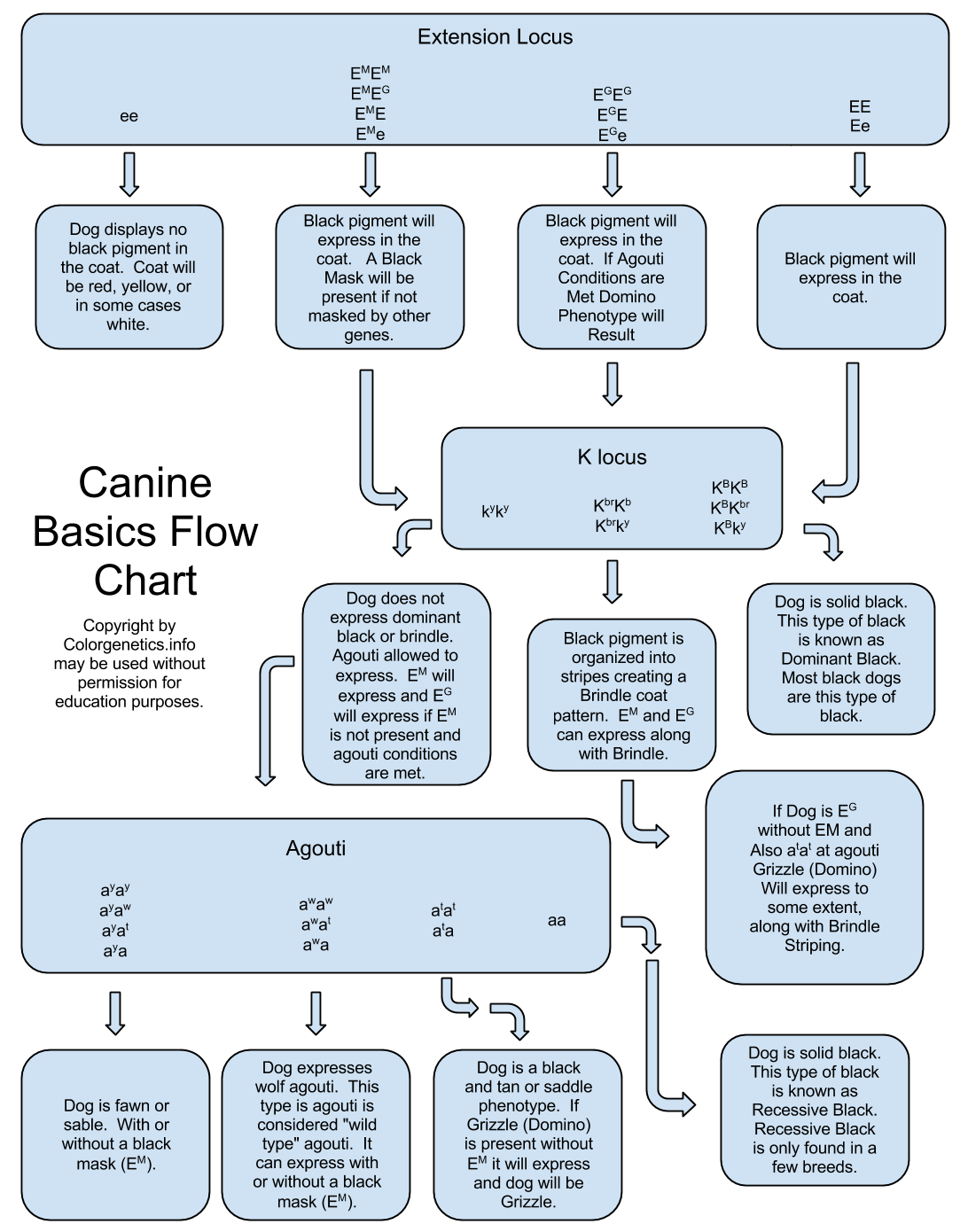

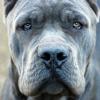
Heelers
I have blue heelers Male and female i have bred them 4 times now this is there 4th litter up till now we have only gotten Blue heelers ( they have only blue on both sides acording to the the people i got them from i have owned the male for 7 years now and the female for 6 ) they are retireing this year also from breding .
my question is Where did the Reds come from .. she had 6 pups thats her normal litter, 3 blue 2 red one hasnt changed from white yet ( they are almost 3 weeks old )there are 2 blues showing some signs of fadeing in this litter and the bitch isnt producing as much milk as her normal.
the remaining 4 are extreamly well feed active and viable pups. Just Red!!
i would like to know if Red is a recessive gene that is shown up and if so is the Age of the parent dogs a factor. does anyone know or have they encountered this
I appologize in advance for my lack of knowledge in this matter but an unasked question i find to be the worst kind of question there is.